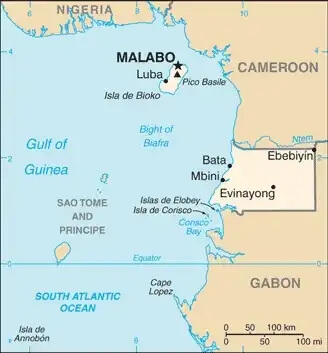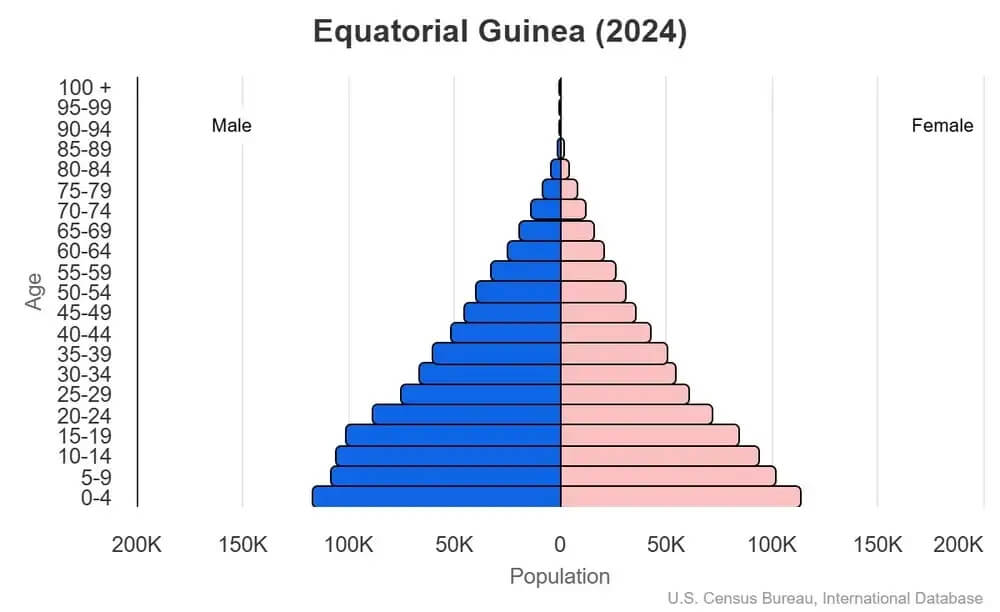World Book
Equatorial Guinea
Introduction
Background
Equatorial Guinea gained independence in 1968 after 190 years of Spanish rule. It is one of the smallest countries in Africa consisting of a mainland territory and five inhabited islands. Major oil reserves were discovered offshore in the late 1990s, but systemic corruption has hindered economic development.
Geography
Area
total : 28,051 sq km
land: 28,051 sq km
water: 0 sq km
Climate
tropical; always hot, humid
Natural resources
petroleum, natural gas, timber, gold, bauxite, diamonds, tantalum, sand and gravel, clay
People and Society
Population
total: 1,795,834 (2024 est.)
Ethnic groups
Fang 78.1%, Bubi 9.4%, Ndowe 2.8%, Nanguedambo 2.7%, Bisio 0.9%, foreigner 5.3%, other 0.7%, unspecified 0.2% (2011 est.)
Languages
Spanish (official) 67.6%, other (includes Fang, Bubi, Portuguese (official), French (official), Fa d'Ambo spoken in Annobon) 32.4% (1994 est.)
Religions
Roman Catholic 88%, Protestant 5%, Muslim 2%, other 5% (animist, Baha'i, Jewish) (2015 est.)
Population growth rate
3.23% (2024 est.)
Government
Government type
presidential republic
Capital
name: Malabo; note - Malabo is on the island of Bioko; some months of the year, the government operates out of Bata on the mainland region.
Executive branch
chief of state: President OBIANG Nguema Mbasogo (since 3 August 1979)
head of government: Prime Minister Manuel Osa Nsue Nsua (since 17 August 2024)
Diplomatic representation in the US
chief of mission: Ambassador Dr. Crisantos OBAMA ONDO (since 27 February 2024)
Diplomatic representation from the US
chief of mission: Ambassador David R. GILMOUR (since 24 May 2022)
Economy
Economic overview
growing CEMAC economy and new OPEC member; large oil and gas reserves; targeting economic diversification and poverty reduction; still recovering from CEMAC crisis; improving public financial management; persistent poverty; hard-hit by COVID-19
Real GDP (purchasing power parity)
$29.248 billion (2024 est.)
$28.985 billion (2023 est.)
$30.539 billion (2022 est.)
Real GDP per capita
$15,500 (2024 est.)
$15,700 (2023 est.)
$16,900 (2022 est.)
Exports
$4.489 billion (2024 est.)
$4.516 billion (2023 est.)
$7.25 billion (2022 est.)
Exports - partners
China 27%, Netherlands 12%, Spain 10%, Italy 7%, Germany 6% (2023)
Exports - commodities
crude petroleum, natural gas, alcohols, wood, scrap iron (2023)
Imports
$3.24 billion (2024 est.)
$3.065 billion (2023 est.)
$3.948 billion (2022 est.)
Imports - partners
China 20%, Spain 17%, USA 10%, Gabon 5%, UK 5% (2023)
Imports - commodities
ships, poultry, plastic products, beer, valves (2023)
Human Development Index
The country's Human Development Index (HDI) is 0.674, ranking it 133rd out of 193 countries tested. (more information)



